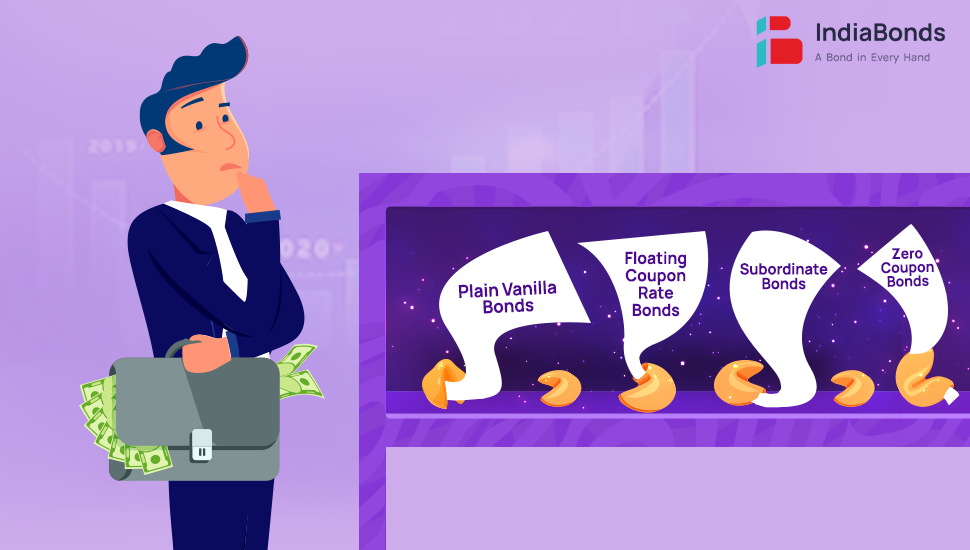Types of Bonds in India

Introduction
Investing wisely in bonds requires a thorough understanding of the different types of bonds available in the Indian market. From the popular government securities to high-yield bonds, there is a gamut of various types of bonds available for the retail investor. This guide explores bonds and its types, equipping investors with the knowledge to enhance their investment portfolios effectively. For further details on bond-related terminology, explore our comprehensive FAQs section.
What are Bonds?
To make things simpler for our readers – Imagine a situation where you get to act as a bank and companies pay you interest on the money you lend out to them! Sounds interesting, doesn’t it? This is exactly how a bond functions. Issuers/companies borrow your money for set time duration and return this money with interest. Issuers utilize these funds to build projects and operations across public and private sectors. From the security of government bonds to the dynamic nature of corporate bonds, each of these comes with varied risk factors allowing you to tailor your investment journey to your goals and comfort.




Types of Bonds – By Issuer
In India, issuers of bonds vary widely and understanding these can significantly influence investment choices: Here are the types of Bonds:
Government Securities (G-Secs): The Government of India issues these types of bonds to fund developmental projects. The sovereign backing makes them the market’s most reliable and substantial segment.
State Development Loans (SDLs): These bonds fund state government projects and provide relatively higher returns than government securities. Each state’s different SDLs receive ratings based on their credit strength.
State Government Guaranteed Bonds: State Government Guaranteed Bonds are bonds issued by state-owned entities and backed by a guarantee from the respective state government. These are primarily aimed at funding specific development projects, such as infrastructure. These bonds’ credit ratings mirror the financial health of the issuing state.
Public Sector Bonds (PSUs): Entities with majority government ownership issue bonds to finance sectors such as power and infrastructure. These bonds are popular due to their strong financial support. However, it is essential to note that PSU bonds do not carry any explicit government guarantee.
Corporate Bonds: Corporate bonds, also known as Non-Cumulative Debentures or NCDs, are financial instruments issued by private corporations to raise capital. Investors who invest in these bonds are lending money to the company for a specified period. In return, they receive periodic interest payments. At the end of the bond’s term, the company repays the principal amount of the bond.
Bank Bonds: These bonds enable banks to raise capital for lending purposes and are among the most regulated issuances. Their risk and return profiles depend on the bank’s financial condition. Based on the bank’s balance sheet, these bonds can be categorized as either senior or subordinated, with the latter having subcategories including Tier 1, Tier 2 and Tier 3. NBFC Bonds: Non-Banking Financial Companies (NBFC) issue these bonds, which constitute a significant portion of the corporate bond market.
Different Types of Bonds – By Structure
Investors have access to all types of bonds based on their structure, offering flexibility in investment strategies:
Fixed Coupon Rate Bonds (Plain Vanilla): These types of bonds represent the most basic category and offer steady returns at fixed payment intervals, making them straightforward investment options.
Floating Coupon Rate Bonds: The coupon rates of these bonds are tied to benchmarks such as the interbank or SBI lending rates. The interest rates adjust based on market conditions, making them suitable for environments with rising interest rates.
Zero-Coupon Bonds (ZCBs): These types of bonds, known as ‘zero coupon’ bonds, do not pay any interest. They are issued at a price significantly below their face value and are redeemed at face value upon reaching maturity. Investors invest in these bonds at a discount and later receive the face value, earning a return from the difference between the purchase price and the redemption value.
Callable and Puttable Bonds: These types of bonds provide the option for either the issuer (callable) or the investor (puttable) to redeem the investment or retrieve their funds before the maturity date.
Subordinated Bonds: Primarily issued by banks, these bonds are subordinate to their ‘senior’ counterparts. Consequently, they carry a relatively higher risk and potentially offer higher returns (coupons) due to their lower claim in the event of issuer bankruptcy.
Perpetual Bonds: These bonds lack a maturity date but provide continuous returns, making them suitable for long-term investors. Additionally, they feature predetermined Call Dates when the issuer may choose to redeem the bonds.
Tax-Free Bonds: Ideal for those seeking tax-advantaged investments, these types of bonds are often issued by entities affiliated with the government. The interest earned on these bonds is tax-free for the investor. They were introduced by the government to attract investors and raise significant capital for developmental needs.
Covered Bonds: They are structured debt instruments backed by a pool of assets, with specific collateral assigned to each bond. This additional security makes them an attractive option for investors.
Principal Protected Market Linked Debentures: These bonds’ returns are tied to market indices or other benchmarks, offering variable returns. Capital Gain Bonds: Capital gain bonds, also known as 54 EC bonds, are issued by PFC, REC and IRFC. They offer significant benefits for those looking to avoid capital gains tax, serving as a strategic investment option following the sale of long-term capital assets such as land or property.
Features of Bonds
Investing in bonds offers several features that can benefit a diversified portfolio:
Security: Particularly, government and highly-rated PSU bonds provide substantial security.
Income Stability: Bonds generally offer predictable and stable returns, appealing to risk-averse investors.
Diversification: They are an excellent tool for risk management, offsetting the volatility of equities.
Tax Benefits: Bonds like tax-free bonds provide tax relief, which can enhance overall investment returns.
Advantages of Bonds
Bonds are attractive due to several inherent advantages:
Predictable Returns: They provide clarity and predictability in income forecasts.
Lower Volatility: Bonds are less volatile than stocks, providing a safer investment in uncertain markets.
Income Generation: They are particularly beneficial for those requiring regular and consistent income, such as retirees.
Diversification: Because they have a low correlation with asset classes such as equities, bonds tend to reduce overall portfolio risk, thereby offering an excellent avenue for diversification.
Advantages of Bonds
Bonds are attractive due to several inherent advantages:
- Predictable Returns: They provide clarity and predictability in income forecasts.
- Lower Volatility: Bonds are less volatile than stocks, providing a safer investment in uncertain markets.
- Income Generation: They are particularly beneficial for those requiring regular and consistent income, such as retirees.
- Diversification: Because they have a low correlation with asset classes such as equities, bonds tend to reduce overall portfolio risk, thereby offering an excellent avenue for diversification.
Limitations of Bonds
However, bonds also come with certain limitations:
Interest Rate Risk: Rising interest rates may lead to a decline in the principal value of bonds.
Reinvestment Risk: There is a risk that falling interest rates will necessitate reinvestment at less favorable rates.
Liquidity Risk: Certain bonds might not be easy to sell rapidly without sacrificing price.
Credit Risk: There exists a risk that the issuer may fail to make prompt payments of interest or principal.
Steps to invest in bonds
Through advent of technology, the landscape of Bond investment in India has changed entirely in comparison to the past few years, making the bond market accessible and transparent to individual investors. IndiaBonds simplifies the whole process to invest in bonds by making it completely digital for you without any hassles.
Here are 3 simple steps on how to invest in bonds Online through IndiaBonds
Head over to IndiaBonds.com and create your account by signing up.
Complete your KYC on IndiaBonds in less than 5 minutes – it’s paperless, requires no uploads, verifies you digitally and you simply add your Bank and Demat details & boom, that’s it. Now you’re ready to start investing in whichever Bonds you prefer either in the primary or secondary market.
Conclusion
Asset allocation is fundamental to portfolio optimization. Specifically, fixed income securities like bonds are crucial for diversification, providing stability, consistent returns and tax benefits. As a retail investor, one can now choose among the types of bonds in India depending on one’s risk tolerance and investment objectives. With the rapid growth of the domestic bond market, platforms like IndiaBonds make it easier for investors to access a variety of bonds online, simplifying the investment process.
FAQs
Q. What is the concept of a bond?
A. Bonds are instruments where the investor lends money to an issuer in return for fixed periodic payments and the principal amount at maturity.
Q. Who should consider investing in bonds?
A. Bonds are suitable for investors looking for stable returns and those who are risk-averse.
Q. How do bonds provide returns to investors?
A. Through regular interest payments and potential price appreciation, bonds offer a dual avenue for investor returns.
Q. What are the three most common types of bonds?
A. The three most common types of bonds are government securities, corporate bonds and high-yield bonds.
Q. What are the 5 characteristics of bonds?
A. The five key characteristics of bonds are face value, coupon rate, maturity date, issuer and creditworthiness.
Q. Which are two features of a bond?
A. Two notable features of a bond are its coupon payment structure (fixed or variable) and credit quality.
Disclaimer: Investments in debt securities/ municipal debt securities/ securitised debt instruments are subject to risks including delay and/ or default in payment. Read all the offer related documents carefully.
















































